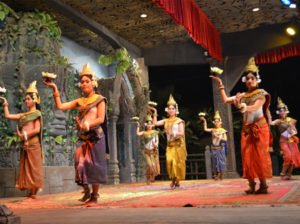Tradition & Culture
Customs and Tradition
Cambodian culture and tradition have had a rich varied history dating back many centuries. Over the years, the people of Cambodia developed a set of unique tradition from the syncretism of indigenous Buddhism and Hinduism.
Cambodians have been raised to respect their culture and are very traditional in their way of life. Tourists will see the well mannered Cambodian expressing a friendly “Chumreap Suor” when they meet one.
Chumreap Suor
Cambodians traditionally greet with a Sampeah, which involves pressing the palms together before the chest with a slight bow and greeting with a polite ‘Chumreap Suor’. Customarily, the higher the hands are held and the lower the bow, the more respect is conveyed. Except when meeting elderly people or government officials, between men, this custom has been partially replaced by the handshake. Women usually greet both men and women with the same traditional greeting. Although it may be considered acceptable for foreigners to shake hands with a Cambodian, it is more appropriate to respect the custom and respond with a ‘Chumreap Suor’.
Traditional Dances
 There are many classical dance forms in Cambodia, of which a highly stylized art form was once confined mainly to the courts of the royal palace and performed mainly by females. Known formally in Khmer as Robam Apsara, the dancers of this classical form are often referred to as Apsara dancers.
There are many classical dance forms in Cambodia, of which a highly stylized art form was once confined mainly to the courts of the royal palace and performed mainly by females. Known formally in Khmer as Robam Apsara, the dancers of this classical form are often referred to as Apsara dancers.
This dance form was first introduced to foreign countries and best known during the 1960s as the Khmer Royal Ballet. The first royal ballerina was Princess Norodom Bopha Devi, a daughter of King Norodom Sihanouk.
The Apsara Dance is particularly inspired by the style from around more than a thousand Apsara carvings in the Angkor temple complex. As evidenced in part by these Apsaras (celestial dancers), dance has been part of the Khmer culture for more than a millennium.
A visit to Cambodia is only complete when one has attended at least one such traditional dance performance.
Kbach Kun Boran Khmer( Khmer Martial Art )
Khmer martial arts date back more than a thousand years, as evidenced by carvings and bas-reliefs in the Angkor temples. The martial arts include Bokator, Pradal Serey, Baok Chambab, Kbach Kun Dambong Vèng, amongst others.
Bokator
Bokator, known formally as Labokatao, is a Cambodian martial art form that involves close hand-to-hand combat, ground techniques and weapons.
Bokator is one of the earliest Cambodian martial art and is said to be the close quarter combat system used by the armies during the Angkor era.
Practitioners are trained to strike with knees, elbows, hands, feet and even the head. Short sticks are commonly used as weapon.
Baok Chambab
Baok Chambab is Khmer wrestling; a sport in which two opponents try to pin (hold) each other’s back to the ground. A match consists of three rounds. Wrestlers perform pre-match ritual dancing. A wrestler wins a match by two out of three rounds. However, after each round, the loser is asked if he still wishes to continue with the match.
A Baok Chambab match is traditional accompanied by drum beats; two drums known as Skor Nhy and Chhmol, (female drum and male drum).
Traditional matches are held at the Cambodian National Olympic Stadium during the Khmer New Year and other Cambodian holidays.
Kbach Kun Dambong Vèng
Kbach Kun Dambong Vèng literally refers to an ancient Cambodian martial art form involving the use of a long staff.
It has traditionally been practiced to prepare against enemies bearing eventual malice towards their villages and their country. Now, it is particularly popular with youths in main sports clubs in Cambodia.
Pradal Serey
Pradal Serey is traditional Khmer kick boxing. A match consists of five rounds and takes place in a boxing ring. There is a one or two-minute break in between each round. Before a match, boxers perform the praying rituals known as the Kun Krou. Traditional Cambodian music is played during a match. The instruments used are the Skor Yaul (a drum), the Sralai (a flute-like instrument) and the stringed Chhing. Boxers are required to wear leather gloves and shorts.
Victory is instantaneously granted when a boxer delivers a knockout which is determined when the knocked down boxer is unable to continue the fight after a 10-second count by the referee. Victory is also determined at the end of the match when judges decide by a point system which fighter was more effective. If the fighters end up with the same score, a draw is called.
